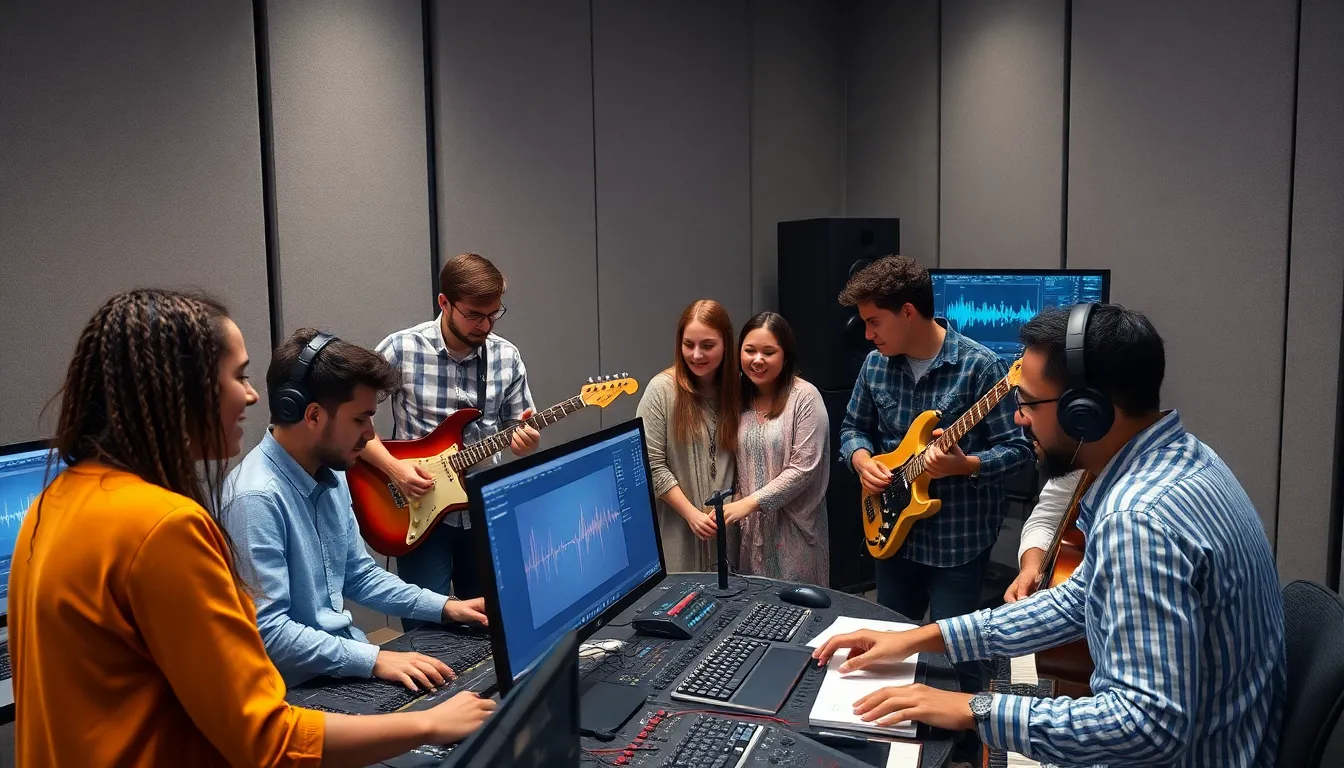In a world where playlists reign supreme and every mood demands its soundtrack, AI-driven music composition is hitting all the right notes. Imagine a virtual composer who never tires, never misses a beat, and can whip up a symphony while you’re still deciding between coffee or tea. This isn’t just a futuristic daydream; it’s happening now, and it’s transforming how music is created and enjoyed.
Gone are the days when creativity was solely in the hands of humans. With AI stepping into the spotlight, musicians can collaborate with algorithms that analyze trends, generate melodies, and even predict what listeners want before they know it themselves. Whether you’re a seasoned artist or a shower singer, AI is here to help you unleash your inner Beethoven—minus the wig, of course. Get ready to explore the harmonious blend of technology and artistry that’s making waves in the music industry.
Table of Contents
ToggleOverview of AI-Driven Music Composition
AI-driven music composition is reshaping how artists create and share music. This technology leverages algorithms to analyze vast datasets, enabling the generation of original compositions tailored to specific genres or moods. Musicians utilize AI tools to access unique sounds and innovative ideas, amplifying their creative potential.
Notable advancements in deep learning have propelled AI’s ability to mimic styles of existing artists, allowing new music to maintain professional quality. For instance, AI systems can dissect popular tracks and generate melodies that align with current trends, giving creators a competitive edge in the marketplace.
Multiple platforms offer users AI-driven composition services. Software applications such as Amper Music, AIVA, and OpenAI’s MuseNet empower users, regardless of their musical background, to compose intricate pieces. With these tools, creators can quickly turn their concepts into fully-produced arrangements.
Collaboration between human artists and AI enhances the music creation process. Real-time feedback allows musicians to adjust arrangements or tempos based on generative suggestions, streamlining the creative workflow. Various genres embrace AI-driven music, from classical to electronic, reflecting a broad applicability of this innovative technology.
Organizations and educational institutions recognize the benefits of AI in music. Workshops and courses incorporating AI tools provide musicians with resources to experiment and improve their craft. Artists increasingly view AI as a collaborator rather than a replacement, fostering an environment of creativity infused with technology.
AI-driven music composition stands at the forefront of the music industry’s evolution, helping artists break boundaries and redefine creativity.
Key Technologies Behind AI in Music
AI-driven music composition utilizes advanced technologies to create and enhance music. Key technologies include machine learning algorithms and neural networks, both essential in shaping how music is generated.
Machine Learning Algorithms
Machine learning algorithms analyze large datasets of music to identify patterns and trends. These algorithms process elements such as melody, harmony, and rhythm, allowing AI to generate new compositions. They also adapt to user preferences, tailoring outputs to specific genres. By utilizing these algorithms, platforms like Amper Music and AIVA enable users to create music that resonates with their intended audience. As the technology evolves, musicians gain access to more sophisticated tools, fostering creativity and innovation.
Neural Networks in Music Creation
Neural networks play a crucial role in AI music composition by mimicking the creative processes of human composers. These networks can learn from various musical styles, effectively replicating the nuances characteristic of different genres. They enhance the quality of generated music by employing deep learning techniques, allowing AI to produce intricate arrangements. Collaborative tools powered by neural networks help musicians experiment with new sounds and structures. By integrating these networks, AI transforms the music creation landscape, enabling unique creative explorations.
Applications of AI-Driven Music Composition
AI-driven music composition finds versatile applications across various fields, enhancing creativity and efficiency in music creation.
Film and Game Scoring
Film and game scoring utilize AI-driven music composition to create immersive soundtracks tailored to specific scenes or gameplay experiences. AI tools generate music that adapts to emotional shifts, ensuring alignment with the visual narrative. For example, dynamic scores can respond to player actions in real time, enhancing the overall gaming experience. Notable platforms like AIVA and Amper Music cater specifically to filmmakers and game developers by offering customizable music solutions. These technologies streamline the scoring process, enabling creators to focus on storytelling while achieving professional-quality audio without needing extensive musical training.
Personalized Music Recommendations
Personalized music recommendations benefit significantly from AI-driven music composition, transforming how listeners discover new tracks. Algorithms analyze user preferences, listening habits, and even context to suggest music that resonates with individual tastes. Services like Spotify use machine learning to curate playlists, incorporating elements from previously liked songs. By understanding patterns within vast datasets, AI continuously refines its recommendations. This approach not only enhances listener satisfaction but also connects artists with audiences, fostering a dynamic relationship within the music ecosystem.
Benefits of AI-Driven Music Composition
AI-driven music composition offers numerous advantages, fundamentally changing the landscape of music creation and interaction.
Enhanced Creativity and Innovation
Innovators leverage AI to push the boundaries of musical expression. New algorithms generate compositions that incorporate diverse styles and elements, sparking fresh ideas. By mimicking various genres, AI enhances the creative process, prompting artists to explore unique combinations. Musicians can blend traditional techniques with advanced technology, leading to groundbreaking sounds. Furthermore, the provision of real-time feedback enables artists to refine their arrangements instantly. Engaging with AI fosters a collaborative environment where imagination thrives, inspiring musicians to experiment and innovate continuously.
Accessibility for Aspiring Musicians
Aspiring musicians benefit significantly from AI-driven tools. These platforms simplify the composition process, making complex music creation accessible to all. Users without formal training can produce high-quality pieces, leveling the playing field in the music industry. Algorithms analyze user inputs, generating tailored suggestions that guide beginners through their creative journeys. Moreover, AI tools allow for quick iterations on melodies and harmonies, enhancing the learning experience. As a result, anyone with passion and creativity can harness AI, unlocking their potential and broadening their musical horizons.
Challenges and Ethical Considerations
AI-driven music composition presents various challenges and ethical considerations. One major concern involves copyright issues. Since AI can generate music that mirrors existing styles, questions arise about ownership and intellectual property rights. Determining whether the creator or the AI itself owns the generated piece complicates the legal landscape.
Another challenge pertains to the authenticity of music. Artists worry that AI-produced compositions may lack the emotional depth often found in human-generated music. While AI can replicate styles, it cannot replicate personal experiences or emotions, which may lead to debates about the value of machine-generated art versus traditional artistry.
Data bias plays a significant role in the effectiveness of AI compositions. If the datasets used to train these algorithms are biased, the resultant music may reflect those biases, impacting the representation of various cultures and genres. Ensuring diverse training sets can help mitigate this issue, making AI a more equitable tool for music creation.
The role of AI raises questions about employment in the music industry. Musicians may fear that increased reliance on AI could diminish job opportunities. Balancing technology and human talent becomes essential to preserve the artistic community while embracing innovation.
Transparency within AI algorithms forms another critical consideration. Without understanding how AI makes decisions, users may doubt the quality and originality of the music produced. Fostering transparency will build trust between AI developers, artists, and audiences.
Ultimately, navigating these challenges involves a collaborative approach. Artists, technologists, and ethicists must engage in ongoing discussions to address these complexities, ensuring that AI-driven music composition enriches the creative landscape rather than diminishes it.
Conclusion
AI-driven music composition is transforming the musical landscape by blending creativity with cutting-edge technology. This innovative approach empowers artists to explore new dimensions in their work while enhancing the listening experience for audiences. As musicians embrace AI as a collaborator, the potential for groundbreaking sounds and unique compositions expands.
Despite the challenges and ethical considerations that accompany this technology, the collaboration between human talent and AI holds promise for the future of music. By fostering a creative environment where artists can experiment and innovate, AI-driven composition is not just a tool but a catalyst for artistic evolution. As this dynamic field continues to grow, it invites both seasoned musicians and newcomers to redefine what music can be.







